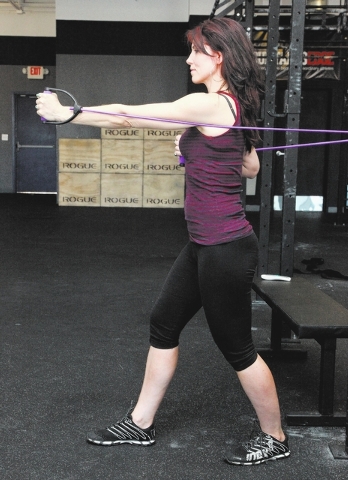Think fast: Speed workouts get muscle fibers firing

Jumping on boxes, fast presses and pullups, why would anyone bother?
Moving fast is an important part of overall fitness. We even have muscles specifically for those tasks. They are called fast-twitch muscle fibers and they can make all the difference in your exercise routine.
One of my favorite ways to teach about fast- twitch muscle fibers is to use resistance bands.
Stretchy bands are a good tool to have in a home gym. They are cheap and versatile. Best of all, they are good for conditioning all types of athletes.
Most major retailers and sporting goods stores in Las Vegas sell them.
Most come with a device that allows you to easily anchor the band to a doorframe. My favorite spot on the door is the hinge side. It allows for a strong and fast relocation of the anchor point along a vertical axis. Depending on the exercise, you may need a low, medium or high anchor point.
Today’s exercises are variations of a basic press, which works the chest and back of the arms, and a row, which works your back. Where I would normally advise control of a slower movement, today is all about speed.
Resistance bands are good for fast movements because of their elasticity. They are generally safer than hand-held weights because there is nothing to drop or fall on you. If things get out of control you simply let go of the bands, allowing them to rebound against their anchor point.
Speed training benefits your fast-twitch muscle fibers. Your muscles are composed of both fast-twitch and slow-twitch fibers in varying ratios depending on the specific muscle. Fast-twitch fibers are generally larger and used for explosive and strength movements because they provide a short, powerful contraction. Slow- twitch muscle fibers are usually smaller and used for stability because of their long-term contractions.
Movements involving high stability condition the slow-twitch muscle fibers to control the body. Fast movements such as running, jumping and explosive lifting use fast-twitch muscle fibers. Just because you don’t expect to do explosive movements doesn’t mean you won’t benefit from training them. For those of you stuck at a strength plateau, they can even help you to break through.
When moving weight or resistance quickly, you often can use less weight than you normally would during a regular resistance-training workout. Use a lighter load so you can move it faster. This lets you perform more repetitions safely and you also may feel your heart rate increase as a result.
Working fast-twitch muscle fibers is advantageous for most athletes. It helps you develop a well-rounded performance and vary your workouts. Athletes in sports can benefit from becoming fast on the playing field and having a powerful swing, throw or kick. If you’re not in sports, your benefits will be strength increases that carry over to the ability to perform daily tasks.
Use today’s exercises by themselves or add them to a circuit to keep your stimulus high. You may find speed work exhausting, so it will transform your old workouts into something more challenging and fun.
If speed work is new to you, you may find that it is a potent form of training. A little goes a long way. Start with a few sets and see how sore you are the next day. Build from there.
Chris Huth is a Las Vegas trainer. He can be reached at 702trainer@gmail.com.